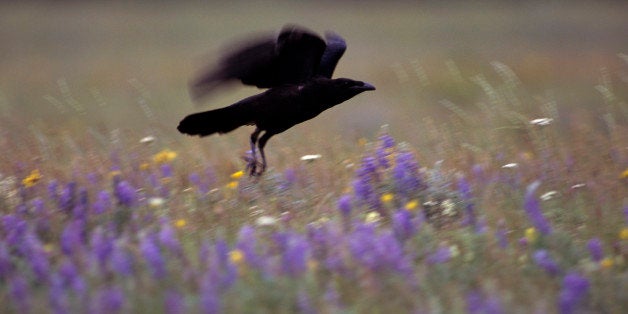
There is a story that, while serving as a young cadet at West Point academy, Edgar Allan Poe was expelled for reporting to a military march wearing nothing but a pair of white gloves. Like most good stories, it appears that this is an urban legend, but there are many unusual details about Poe's colourful life and work which are certainly true. Although he is celebrated for his short stories, Poe the poet is also a fascinating figure whose poetry has left us with some surprising legacies.
Poe's most celebrated poem 'The Raven' was inspired by the works of two Victorian writers: by the talking raven Grip in Dickens's Barnaby Rudge (1841), and (for its rhythm and meter) by Elizabeth Barrett Browning's poem 'Lady Geraldine's Courtship.' It is perhaps his single best-known work, even more famous than his short stories. Even those who have never read Poe know 'The Raven,' perhaps thanks to The Simpsons (which has also adapted and drawn upon several other Poe works, including his short story, 'The Tell-Tale Heart'). The legacy of the poem also passes over into sport. The American football team the Baltimore Ravens are named in honor of Poe's poem.
But what is less famous is the story behind Poe's choice of bird. There is reason to believe that Poe originally planned to have a parrot, rather than a raven, utter the refrain 'Nevermore' in the poem. In his 'Philosophy of Composition,' he wrote that in his mind there 'arose the idea of a non-reasoning creature capable of speech; and very naturally, a parrot, in the first instance, suggested itself, but was superseded forthwith by a Raven, as equally capable of speech.' Whether Poe was merely retrospectively having us on (he wasn't exactly a stranger to pulling the wool over his readers' eyes, as witnessed by his infamous 'Balloon-Hoax'), or whether he was being genuine, cannot be known for sure; but the parrot does seem the natural choice for a bird capable of mimicking human speech.
Poe also wrote poems in prose, such as his 1848 prose-poem Eureka, which predates, and predicts, the Big Bang Theory by some eighty years. In the poem he posits that the universe began from a singularity, which gave rise to all of the particles in the universe. Eureka even anticipated some of the arguments later put forward by Lord Kelvin to solve the cosmological problem known as Olbers' Paradox. If the universe is static and there are an infinite number of stars within it, the Paradox states, then surely anywhere you look in the night sky you must be able to see a bright star, so the night sky should be bright rather than dark. Poe suggests, in Eureka, that the reason this is not the case is that some stars in the universe are so far from us that their light has not yet reached us; because the universe is expanding rather than static, many of these stars are too far from us for us to see any of their light. Poe considered Eureka his masterpiece, though it is among his least read works today.
According to Lizzie Doten, Poe carried on writing poetry even after he'd died. Doten, a psychic medium, made this somewhat outlandish claim in her 1863 book, Poems from the Inner Life, published fourteen years after Poe's death. The volume included poems which Doten claimed to have received from the ghost of Edgar Allan Poe. Critics and readers were skeptical, to say the least.
It is well known that Poe died penniless on the streets of Baltimore, aged just 40, in 1849. But what is less well known is the fact that Poe had never made a vast amount of money from his writing, and the only book 'by' Poe which was successful enough to be reprinted during his lifetime was a non-fiction work on molluscs (which he didn't so much write as put together, by editing a much longer work by someone else). But the posthumous value of his poetry is a different story. Only 12 copies of his first book, Tamerlane and Other Poems (1829), are thought to survive; only 50 were printed. In 2009, one of these copies sold at auction for $662,500. In July 2013, a handwritten copy of another of his poems, 'The Conqueror Worm,' fetched $300,000 at auction in Massachusetts.
Oliver Tearle is the author of Bewilderments of Vision: Hallucination and Literature, 1880-1914 (Sussex), out in paperback this month.